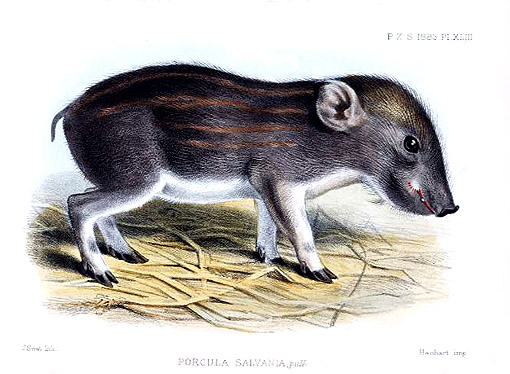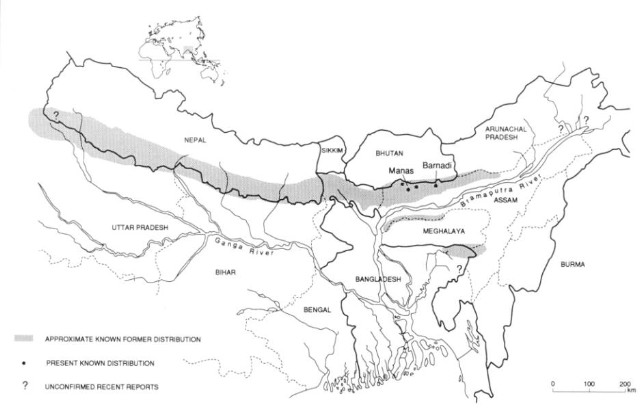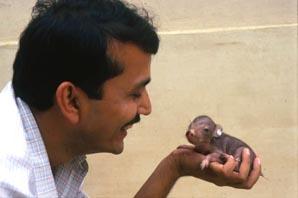
May 21, 2008

Porcula salvania (“Pigmy Hog of the Saul Forests”), as shown in a hand-drawn lithograph by Joseph Smit for the Proceedings of the Zoological Society.
Good-looking, sexy animals get all the media attention, and the unique may be ignored due to human favoritism generally going to the attractive animals. Who cries for the plight of the poor pigs?
The pygmy hog (Porcula salvania) formerly was spread across India, Nepal, and Bhutan and now only is found in the wild in Assam. Today, the world population, not in captivity, totals a mere 150 or fewer.

The species is more than a mere hog, for it is the only member of the genus Porcula, a unique evolutionary branch of pigs. Conservation of the species has been hampered due to the lack of human interest and gap in public support, unlike that for the charismatic South Asian mammals such as the orangutan, Bengal tiger, Indian rhino, or Sumatran rhino.
The world’s rarest wild hog
The pygmy hog is, indeed, the world’s rarest wild hog and most threatened by extinction. It stands about 25-30 cm from the ground and weighs up to 9 kg.

The species was originally found in the narrow belt of alluvial tallgrass habitat that runs across the southern edge of the Himalayas in the Indian subcontinent. Tallgrass habitats, being very rich in nutrients, are highly suitable for cultivation and therefore came under significant pressures from expanding human populations, agriculture and uncontrolled harvesting; all of which caused the hog to die out. The continued practice of indiscriminate dry season burning and livestock grazing still threatens the last population in Manas.

Now, after more than 10 years of captive breeding, the Durrell Wildlife Conservation Trust (the organization alerts us) will release three families of pygmy hogs – the world’s smallest wild pig – in to wild grasslands in Assam, India, from the only captive population of the species in the world.
Thought extinct in the 1960s
John Fa, Director of Conservation Science for Durrell, says: “The pygmy hog was thought to be extinct in the 1960s as its habitat was disappearing due to human encroachment, livestock grazing and grass burning, but in 1971, the species was rediscovered in Assam. So, together with their partners, Durrell established the Pygmy Hog Conservation Program in 1995 for recovery of the species.
“The program aimed to study the causes of decline in the species and establish a sustainable captive population, which could be used to reintroduce animals back to their restored native habitat. The conservation breeding has been extremely successful and we are now ready to release them back in to the wild in May 2008 before the monsoon season begins.”
The hogs will be released in the Gelgeli grasslands of Sonai Rupai Wildlife Sanctuary in Assam. Durrell, a charity that relies on donations to support its conservation programs, has worked closely with the Sanctuary authorities to improve protection and control dry season burning of grasses. Sanctuary staff have also been trained in wildlife monitoring and habitat management.
A breeding facility was established at Basistha near the Assam capital, Dispur with the aim of raising a captive population ready for release back in to the wild. The program is currently supported through a grant from the UK government’s Darwin Initiative.
Captive breeding
Six wild hogs (two males and four females) were captured from Manas, Assam, in the Himalayan foothills in March 1996 and brought to the Basistha breeding facility. John Fa continues: “The breeding was a significant success and within five years the captive population rose to 77. A young wild hog rescued from a river in Manas was also added to the stock in 2001 and we currently have 79 pygmy hogs, which is the only captive population of the species in the world.”
Pre-release site for acclimatisation
Three small family groups of hogs, containing 16 individuals in total, are currently in a pre-release site established at Potasali near Nameri National Park, Assam. This site contains large enclosures that replicate the hogs’ natural grassland habitat. The animals have been kept here for the past four and a half months, which has allowed them to become used to the conditions they will face in the wild and reduces contact they have with humans. Up to release date, the hogs have shown naturalistic behavior and an aversion to human contact which is a positive sign that they will fair well when released.
Tall-grass critical habitat for several endangered species
The pygmy hog acts as an indicator for the state of the tall-grass habitat, which is crucial for the survival of a number of other endangered species such as the swamp deer (Cervus duvauceli), wild buffalo (Bubalus bubalis), hispid hare (Caprolagus hispidus) and Bengal florican (Houbaropsis bengalensis).
The Pygmy Hog Conservation Program is as an umbrella for extensive work with both the habitats and their surrounding communities. The Durrell Wildlife Conservation Trust hopes that through this project and the release of hogs, they can support local communities to sustainably manage their natural resources and protect their biodiversity.
About Loren Coleman
Loren Coleman is one of the world’s leading cryptozoologists, some say “the” leading living cryptozoologist. Certainly, he is acknowledged as the current living American researcher and writer who has most popularized cryptozoology in the late 20th and early 21st centuries.
Starting his fieldwork and investigations in 1960, after traveling and trekking extensively in pursuit of cryptozoological mysteries, Coleman began writing to share his experiences in 1969. An honorary member of Ivan T. Sanderson’s Society for the Investigation of the Unexplained in the 1970s, Coleman has been bestowed with similar honorary memberships of the North Idaho College Cryptozoology Club in 1983, and in subsequent years, that of the British Columbia Scientific Cryptozoology Club, CryptoSafari International, and other international organizations. He was also a Life Member and Benefactor of the International Society of Cryptozoology (now-defunct).
Loren Coleman’s daily blog, as a member of the Cryptomundo Team, served as an ongoing avenue of communication for the ever-growing body of cryptozoo news from 2005 through 2013. He returned as an infrequent contributor beginning Halloween week of 2015.
Coleman is the founder in 2003, and current director of the International Cryptozoology Museum in Portland, Maine.
Filed under Breaking News, Cryptotourism, CryptoZoo News, Cryptozoologists, Cryptozoology, Extinct, Pop Culture, Weird Animal News